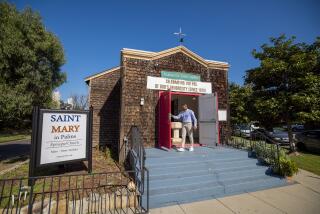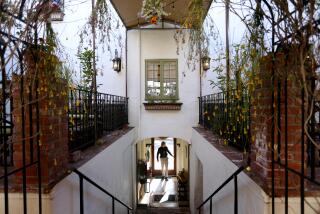Neighbors Unfriendly to Churchâs Plan
YORBA LINDA â Plans by a Quaker church to turn a wooded glen of older homes and horse trails into a parking lot for more than 900 cars are running into a stumbling block: the neighbors.
Since 1994, Yorba Linda Friends Church, the largest Quaker congregation in the country, has been buying up land and demolishing houses for the proposed 6-acre parking lot. The lot would adjoin a planned multimillion-dollar sanctuary as big as the behemoth Crystal Cathedral in Garden Grove.
While 10 homeowners along the calm jasmine- and eucalyptus-scented streets near the church property have agreed to sell their land, a small group of residents has resolved to stay and fight.
âWeâre not saying that the church is an evil empire or anything. Weâre just saying that we donât want our neighborhood turned into a parking lot,â said Daniel Fattori, whose home on 1 1/2 wooded acres at the end of a tranquil cul-de-sac would be surrounded on three sides by parking.
Fattori and about half a dozen neighbors are writing letters to city officials and planning a petition drive to battle the proposal. But with most people who lived along the street long gone, their buyout money with them, he and other neighbors fear the fight may be lost already.
âI grew up here,â Fattori said. âI saw this place being built as a child and it was my dream to actually move into it as an adult. I want to stay here. Why do I have to move out? Why canât they leave my street alone?â
With average weekend attendance exploding from 256 in 1985 to more than 3,500 today, the church has no choice but to grow, said its business administrator, Tom Babnick.
Along with the 2,862-seat sanctuary and the 6-acre addition to the existing parking lot, church officials propose building a 30,000-square-foot classroom and office building, and expanding a private grade school and kindergarten by three more grades, from 590 to about 700 students.
âWe are not building this new sanctuary and saying, âIf we build it, they will come,â â Babnick said. âWe are building it because they are coming already and we have no way to accommodate them.â
A draft of the plans was submitted to city staff early this year. At the cityâs request, the church this month hired a consultant to prepare an environmental impact report on the project.
âThere are never any guaranteesâ of approval, said Yorba Linda Mayor Mark Schwing. âThey have a right to acquire property. But that doesnât mean weâre going to let them build on it until weâve reviewed the proposal.â
With only a conditional use permit and a design review required from the city, church officials have not waited to start their plan in motion.
*
Since 1994, they have spent more than $4 million in church funds to buy 10 homes on 7 acres near the church. They have held a series of meetings with homeowners who have chosen to stay, warning them that noise and the emissions from hundreds of cars are in their future. This spring they demolished the first two houses they acquired.
Meanwhile, church officials have been working to finalize their plans, which call for a 70,000-square-foot sanctuary, and for keeping the churchâs current 36,000-square-foot, 750-seat sanctuary intact.
The church hopes to break ground on the $15-million project by 1999, Babnick said.
âWe feel weâre going to make the area a lot nicer in some ways than it was before,â Babnick said.
The residents who live along Mountain View and Highland Avenues see it differently.
The area of 1940s-era homes is just a block off busy Yorba Linda Boulevard, but is so covered with trees and shrubbery that it feels like a different world. A bike trail winds through the area and up a state-owned mountain beyond. In the mornings, equestrians often ride their horses down the street to a nearby creek.
But in the past few years those who have not chosen to accept buyout offers from the church have watched their neighbors move out, one by one. Once-flourishing gardens have been allowed to die. Traffic in and out of the church on weekends has surged.
âItâs terrible; it was like you were surrounded by family before,â said Geoffrey Haddad, who lives across Highland Avenue from the proposed parking lots. âWeâd have barbecues together. Weâd visit one another. Now no oneâs left. Now instead of neighbors across the street Iâm gonna have a sound wall and a parking lot. Itâs all changed.â
More to Read
Sign up for Essential California
The most important California stories and recommendations in your inbox every morning.
You may occasionally receive promotional content from the Los Angeles Times.










